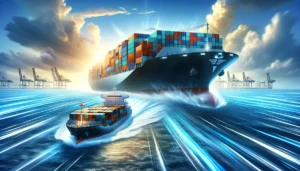After a year like 2020, many freight forwarders are left wondering what the international shipping industry can expect to see in 2021. When you take a look at the companies leading logistics publications like FreightWaves named as winners of their 2021 FreightTech 100 Awards, a pattern starts to emerge. In order to better manage the chaos of today’s freight marketplace, differentiate yourself from your competitors, and improve your margins, you’ve got to invest in innovative freight forwarding technology that allows you to offer more reliable service.
It’s easy to talk about wanting to disrupt the shipping industry. The hard part, however, is figuring out how. For example, how do you know which logistics freight technology is right for your company? The industry has transitioned from questioning whether or not investing itself is the smart move to the question of which types of freight forwarding solutions companies should be using. With so many freight forwarding software features and tools to choose from, the decision can be overwhelming.
Adding to that are the many new logistics solutions constantly coming to market. To help freight forwarders understand what’s out there and more easily narrow down their options, here are the top logistics technology trends of 2021:
1. Artificial intelligence/machine learning platforms
More and more freight forwarders and their supply chain partners are integrating artificial intelligence (AI) and machine learning platforms into their shipping processes to streamline their operations. According to the most recent MHI Industry Report, 60 percent of supply chain professionals in manufacturing, transportation, and other industries expect to be using AI and machine learning platforms within the next five years.
There are many different applications of this kind of logistics freight technology, such as predictive analysis, route optimization, document automation, inventory management, etc. With faster logistics communications, rapid responsiveness, and quicker turnaround AI/machine learning freight forwarding software features can boost profits and keep your customers happy.

2. Automated AP/AR tools
Another trend that’s predicted to take off in 2021 is monthly subscription-based automated accounts payable/accounts receivable tools. Self-service systems like these provide freight forwarders with a way to accurately measure a carrier’s performance against what they’re charging on freight invoices to ensure that logistics service providers are sticking to the initial contract agreement.
By analyzing real-time shipping data and pulling information from your negotiations without taking a percentage of your freight invoices like a typical freight audit firm would, automated AP/AR tools are able to help forwarders maximize their cost savings. Many are also built to easily integrate with your existing accounting systems, so the implementation process is straightforward as well.

3. API and EDI reporting
Shipment visibility is crucial when it comes to troubleshooting transportation issues and keeping deliveries on time. API and EDI reporting gives freight forwarders instant access to reliable, up-to-date shipment status information, which eliminates the need to go through multiple systems to figure out answers to time-sensitive questions.
This freight forwarding technology trend can also help forwarders and shippers prevent inaccurate data entry as well as hold carriers accountable for chargebacks by monitoring the entire order cycle and providing solid proof that every party involved can reference. For those looking to stay on top of their shipping transactions and improve their supply chain relationships, this next-generation reporting is a surefire way to enhance data flow and provide sufficient evidence for trade compliance.

4. Robotic process automation
RPA technology is a type of software that’s been taught to mimic human interaction and replace typical back-office work by executing core business functions. Just as you or any other individual would do, it navigates whatever systems your company is currently using to capture and communicate information.
Basically, RPA freight forwarding software performs a variety of repetitive, computer-based tasks and processes (like manual data entry) for your forwarding business. The only difference is that it won’t make mistakes, which officially establishes it as every employers’ dream. Similar to automated AP/AR tools, the implementation process is also a lot shorter and more cost-effective than some of the other leading alternatives, and it can leverage your existing infrastructure.
There are a lot of different factors that need to be considered before investing in new freight technology, but the first thing to focus on is your end goal. Some forwarders may want freight forwarding technology that helps them increase efficiency by automating back-end processes, while others may want a customer-facing platform that can expand their market reach and reduce sales costs.

Once you figure out the specifics of what you want to accomplish with your company’s resources, you’ll have a better idea of the type of logistics forwarding technology that will work best for you. Click here to learn more about how GoFreight’s full suite of freight forwarding software solutions helps freight forwarders tackle a wide variety of goals.



